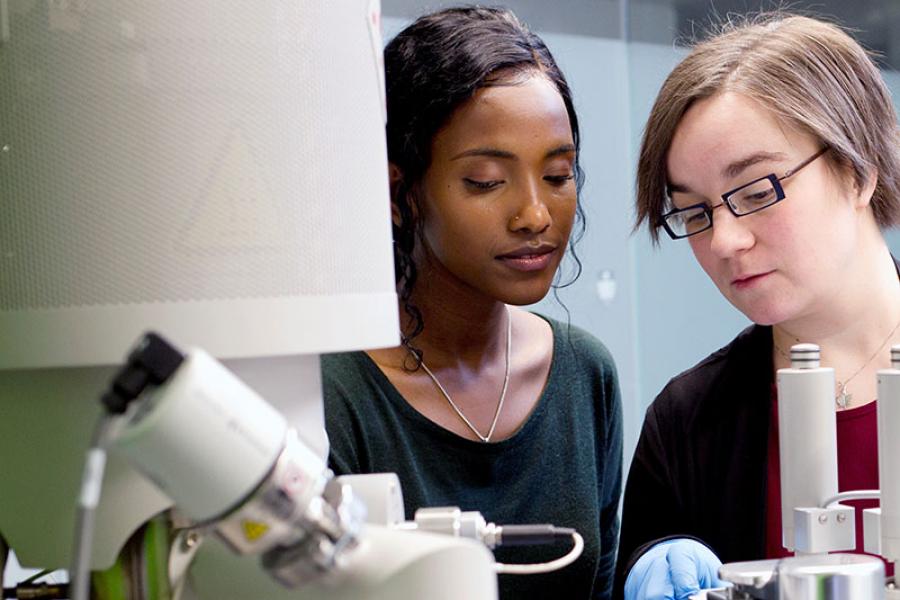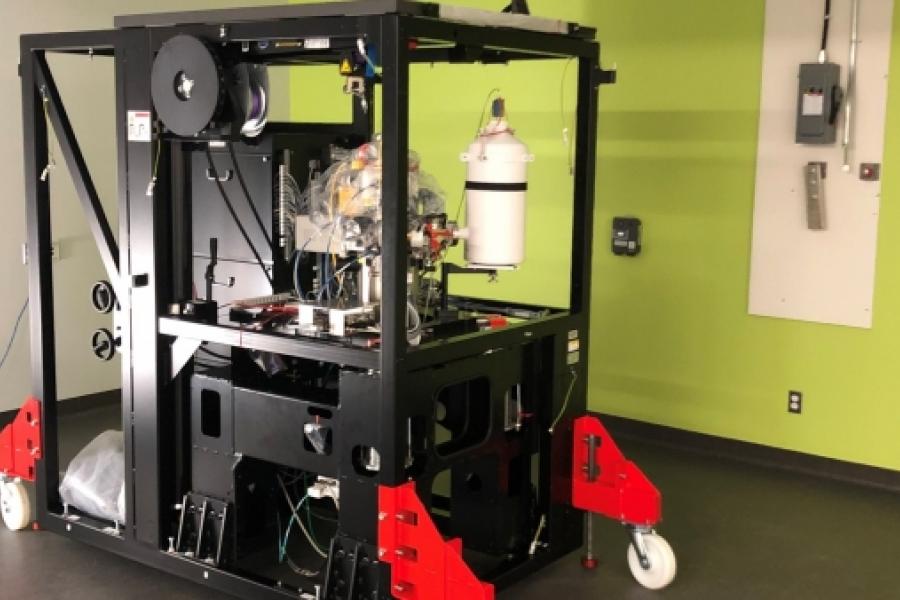BioExM hosts a breadth of expertise in synthetic, structural and digital biology. From new approaches to drug design to biosensors, environmental sustainability, and large data analysis our researchers are providing biology-based solutions to emerging challenges facing our communities and the world.
BioExM
Welcome to BioExM!
BioExM is a network of researchers, students, and industry that will work together to further research in three main pillars: Structural Biology, Synthetic Biology, and Digital Biology.
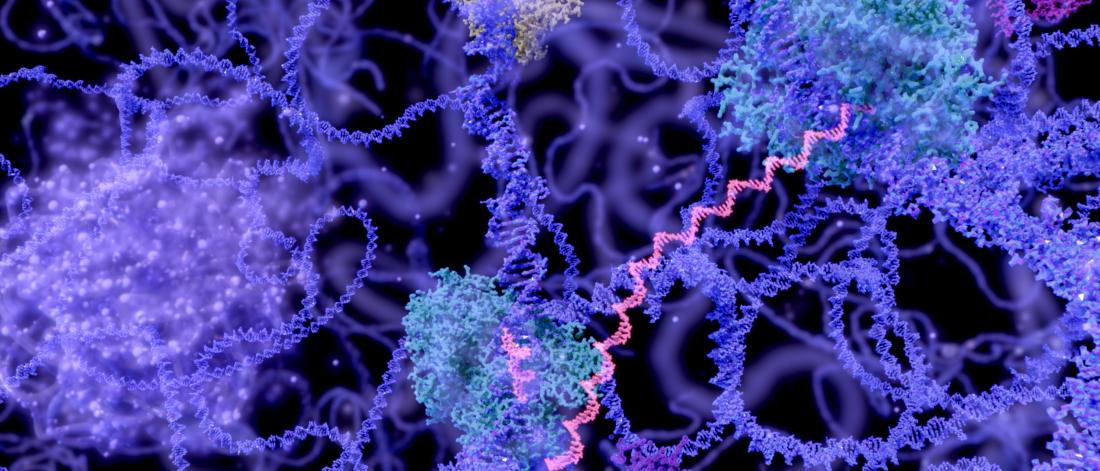
BioExM
Creating a vision for biotechnology in the prairies
On this page
What we offer
We offer advanced resources and expertise in structural, digital, and synthetic biology. We provide biologically-based solutions to myriad challenges in diverse sectors such as agriculture, energy and medicine.
Our network utilizes two facilities, the Manitoba Institute of Materials which houses a Cryo-Electron Microscope, and a crystallography facility, in the Faculty of Science. BioExM’s strong connections to the Manitoba Centre for Proteomics and Systems Biology (MCPSB) facilitate interactions and services for all types of OMICS research.
Areas of expertise
Re-imagining the genetic code for smart materials and sustainability
Ned Budisa, professor at the department of chemistry and (Tier 1) Canada research chair in Synthetic Biology has pioneered the production of synthetic proteins containing modified residues at predefined sites. He has incorporated more than 200 amino acids with different side-chain modifications into synthetic proteins using this approach. This expansion of the genetic code enables the possibility for many still unanticipated protein-based technologies Budisa has dedicated his time at the University of Manitoba in pursuit of applying his protein-based technologies to evolve enzymes and microbes for bioremediation of plastics and organic pollutants, to develop protein-based drug delivery systems, and to engineer biosensors and nanodevices for diagnostic purposes.
Developing new therapeutics and drugs to treat human diseases and cancer
As a (Tier 1) Canada research chair in Structural Biology and Biophysics and professor at the Department of Chemistry, Jörg Stetefeld is working toward a molecular understanding of the structure-property relationships of extracellular proteins involved in the formation of dynamic high-order signalling complexes related to human disease. He is also examining the establishment of unique S-layer assemblies from extremophilic archaea. This research aims to improve our understanding of the signal complex formation and the mechanistic assembly of extracellular S-layer structures with great stability. This is essential for the development of structure-based applications in the fields of biomedicine and biotechnology. Leading to the development of new drugs to treat human diseases, including COVID-19, and various types of cancer, and the design of artificial protein assemblies.
Uncovering the principles of biomolecular design
Hans-Joachim Wieden, professor at the department of microbiology and lead for BioSciences Entrepreneurship and Industry Partnerships, specializes in design-focused discovery research with particular emphasis on ribosome-dependent protein synthesis. The ribosome is a megadalton molecular machine that is composed of two types of biomolecules fundamental to life, RNA and proteins. Wieden uses a multi-disciplinary approach combining classical preparative biochemistry and rapid-kinetics, with advanced structural biology (Cryo-EM) and computational techniques (Molecular Dynamics Simulations) to extract fundamental principles of biomolecular function and to describe, predict and manipulate their performance. This approach is therefore applicable to many biomolecular systems beyond the ribosome, truly enabling the molecular design of next-generation bio-inspired solutions from the ground up.
Delivering safe and specific pesticides
Steve Whyard, professor at the department of biological sciences and associate dean (research) at the Faculty of Science, is developing an RNA interference technology that applies double-stranded RNA (dsRNA) to knock down sequence-specific gene expression and offers a new generation of pesticides that are species-specific and therefore do not adversely affect non-target species. Due to the ease by which new pesticidal RNAs can be developed, Whyard’s technology could be applied to a vast array of other pests and pathogens of crops, other pests of our homes and urban environments, and other food production systems. His research group is currently developing RNA-based pesticides to control specific disease-carrying mosquitoes, insect pests affecting canola crops, and fungal pathogens affecting several commercially important crops. As an extension of this work, they are also investigating novel RNA delivery systems. As RNA-based pesticides are readily biodegradable and so species-specific, they have the potential to be applied in many food production systems where chemical pesticides are not tolerated, either for health or environmental protection reasons.
Using an atomic-level approach to predict small molecule design and activity
Rebecca Davis is an associate professor at the department of chemistry and her research is at the intersection of chemistry and biology and delves deep into the atomic level to investigate how small molecules invoke their activity based on their interactions with proteins. With this granular information, she then uses high-powered state-of-the-art computational approaches to predict features of other small molecule-protein binding interactions and energies to design improved drugs. With expertise in organic chemistry, Davis’s lab is then able to synthesize these newly improved compounds for experimental validation. This approach to studying small molecule interactions can be applied to a range of areas within and beyond medicine and Davis has been applying these methods to solve problems in antibiotic resistance, Gauche’s disease, and the toxicity of environmental pollutants.
Bringing diagnostics to the bedside with electrochemistry
Sabine Kuss, an award-winning electrochemist and assistant professor at the department of chemistry, aims to reduce the time for diagnostics to a matter of minutes with the development of biosensors that can be incorporated into handheld devices for use in the clinic. Using electrochemistry, these sensors are able to detect substances that cross the outer layer of live bacteria and cancer cells. By detecting which substances, the bacteria or cancer cells expel, scientists can tell whether a cell is susceptible or resistant to a specific medication and therefore can rapidly select the most appropriate drug for treatment.
Working with Canadian communities for environmental monitoring and bioremediation
Gregg Tomy, professor at the department of chemistry and director at the Centre for Oil and Gas Development (COGRAD), is developing and applying cutting-edge environmental monitoring tools, including gas chromatography-tandem mass spectrometry (GC-MS/MS) for the detection of petroleum chemicals like polycyclic aromatic compounds (PACs), bioinspired monitoring and remediation tools, and eDNA metabarcoding approaches. Using a broad spectrum of world-class chemical analysis tools in conjunction with innovative applications in the field of bioremediation and monitoring, they are making discoveries across the country from projects in the Alberta Oil Sands to the Canadian Arctic in close collaborations with Environment and Climate Change Canada and members of several First Nation communities.
Developing efficient algorithms to tackle complex problems
Olivier Tremblay-Savard, associate professor at the department of computer science, primarily conducts research in Comparative Genomics, a field where complex biological problems include distance calculations, reconstruction of ancestral genomes, and inferences of evolutionary patterns. Using an interdisciplinary approach involving Computer Science, Biochemistry, Microbiology, Molecular Biology and Evolutionary biology, Tremblay-Savard develops efficient algorithms to tackle these and other complex problems. With a background in algorithmic, theoretical computer science, human-computer interactions and gamification, he is able to approach these problems from many different angles and is also able to create user-friendly, accessible, clear and engaging software.
Predicting antibiotic activity with Artificial Intelligence
Silvia Cardona, professor at the department of microbiology, is a microbiologist collaborating with Pingzhao Hu, a computer scientist and Rebecca Davis, a chemist to develop an Artificial Intelligence (AI)-driven tool to predict antibiotic activity in expansive virtual compound collections to screen for highly active molecules. Cardona’s unique platform integrates the global cellular response of bacteria to antibiotics with detailed descriptions of chemical structures and yields information on novel antibiotic mechanisms of action. Coupling high-throughput experimental data generation with AI-driven data modelling makes drug discovery automatic and fast.
Leveraging non-coding RNA to forge new cancer therapeutics
Sean McKenna seeks to understand the roles that non-coding RNA plays in the regulation of human disease states, with a focus on cancer. He uses a combination of Biochemistry, Molecular Biology and Cell Biology to identify the biochemical pathways that these non-coding RNAs participate in and the protein complexes that they regulate. Integration of synthetic biology approaches has allowed the addition of unconventional chemical groups to RNA. These modifications are unique to human cells and allow McKenna to specifically identify binding partners of non-coding RNA, regulate the levels of specific non-coding RNA, or visualize RNA in a cellular context. Therapeutic approaches with unconventional RNA modifications have the potential to specifically target the non-coding RNA involved in some of the lesser-studied cancer pathways opening new hope for treatment.
Research facilities
The BioExM network provides opportunities for members to use equipment that may not otherwise be available. For details on how to access equipment, please contact Ned Budisa at nediljko.budisa@umanitoba.ca
Education - Prairie iGEM
The education arm of the BioExM Network includes the Prairie iGEM Team, which is an interdisciplinary undergraduate student group that researches and designs solutions to real-world problems through the employment of techniques in synthetic biology, genetic engineering, and microbiology.
What is iGEM?
The International Genetically Engineered Machine (iGEM) Foundation is a non-profit organization that encourages the development of an open and collaborative community focused on the advancement of synthetic biology via education, competition, and collaboration. The iGEM cycle provides a brief overview of an iGEM team project timeline: team recruitment, project development, genetic design(s), testing, data analysis, troubleshooting, video production, and project presentation at the iGEM competition.
The iGEM competition showcases work from team projects focused on biosynthetic engineering, where teams are encouraged to solve real-world problems using synthetic biology (i.e., building novel devices). The overall objective of this annual competition is for teams to create reusable parts known as BioBricksTM, which are genetically encoded parts of characterized (standardized) functions. These BioBricksTM are then incorporated into a standardized registry and their function can be applied from one project to another.
In this competition, teams highlight their work by creating a team wiki, a promotional video, and a research poster to present their project. Aside from the competition, students are able to engage and work with like-minded individuals and expand their professional network, while further developing their skills and applying their knowledge to a project on a topic of interest.
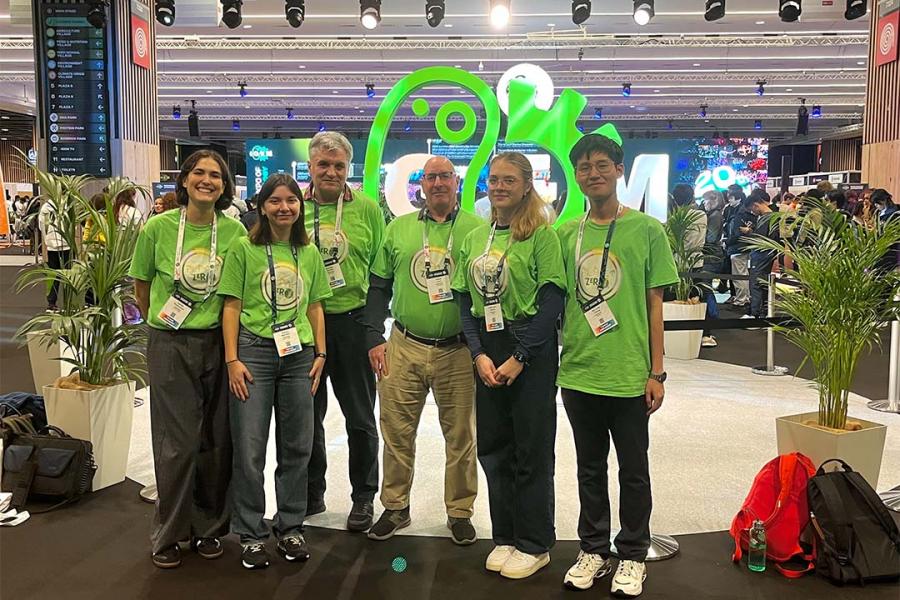
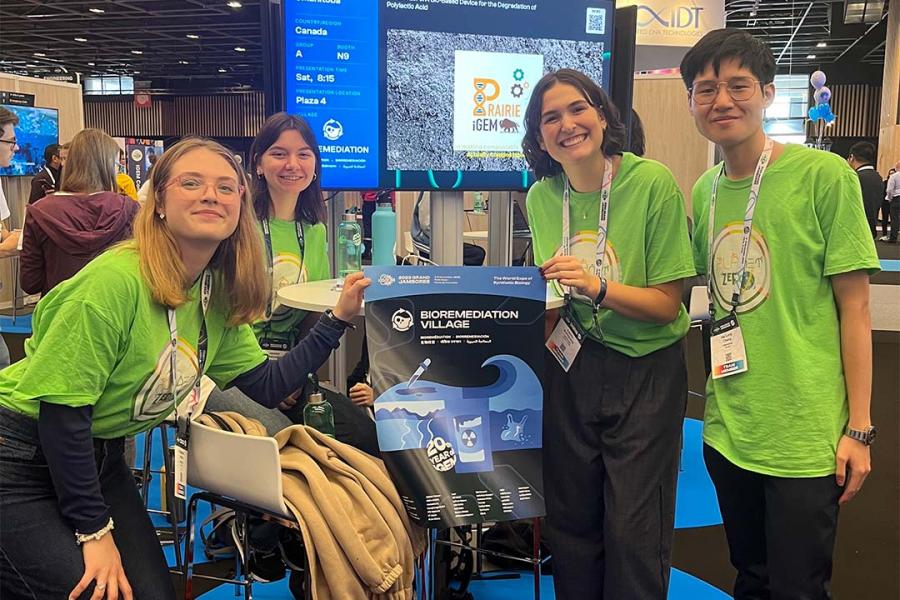
Our Prairie iGEM team
Introduction
The Prairie iGEM team is a cornerstone for promoting student engagement and advances in Synthetic Biology on our Campus. Inspired by the global prominence of the iGEM competitions, which serve as platforms for showcasing cutting-edge research and innovation, University of Manitoba professors wanted to provide their students with a similar opportunity for exploration and collaboration.
Establishment and support
With the support of the Faculty of Science, who had the foresight to recognize the value of such advanced student activities, preparations for the Prairie iGEM team began in 2019, culminating in the launch of wet lab activities in 2020. In the years that followed, remarkable progress was made as our team actively participated in the prestigious Grand Jamboree in Paris, achieving notable success, including a silver medal in 2022 and 2023. This success not only strengthened our university's reputation but also underlined our commitment to excellence in synthetic biology research and teaching.
Interdisciplinary collaboration
The overwhelming enthusiasm of UM students for the iGEM initiative reflects its profound impact, which transcends departmental boundaries and attracts participants from various faculties, including Agriculture (engineering) and Arts (sociology). As a result, iGEM has been designed to become an established tradition at the University of Manitoba, fostering interdisciplinary collaboration and innovation.
Our team’s members come from diverse educational backgrounds, which allows us to take an interdisciplinary approach to problem-solving and encourage the generation of innovative solutions through the collaboration of different disciplines.
Skill development
Through iGEM, students can apply their theoretical and practical knowledge while addressing real-world problems. Members can further develop their skills as scientists, gain experience in the lab and learn new techniques (working as a team and independently) by conducting research experiments.
Prairie iGEM is strengthening the Manitoba SynBio (synthetic biology) community, helping students gain experience performing lab work and other aspects of research: experimental design, fundraising, technology and presenting. Students take the initiative by connecting with stakeholders for project insight, feedback and potential funding.
Teams are also required to create a wiki webpage, a promotional video and a project poster to display team information and present their project. Here, students gain experience creating a research poster and communicating their project to an audience. Students can further develop skills in communication and content creation (website building, promoting, or presenting their work), which are highly transferrable to future endeavours outside of iGEM.
Current project for 2024: A Bio-Based Device for the Degradation of Poly-Lactic Acid
In 2024, our team is building upon our silver-medal-winning 2023 project PLAnet Zero. This project uses synthetic biology to address the current issues with composting poly-lactic acid (PLA) bioplastics in Manitoban composting facilities. PLA degradation requires specific temperature and moisture conditions that are difficult to maintain in our composting facilities, preventing PLA degradation and causing it to be instead diverted to landfill. As local businesses attempt to go green and switch to these compostable plastics, plastic pollution is only worsening.
To this end, we are developing a biological device that uses enzymes to degrade PLA, allowing for bioplastic composting in our current infrastructure. Our project consists of:
- The use of novel amino acids to create synthetic PLA-degrading enzymes with increased efficiency and effectiveness.
- An engineered bacterial organism that can make these PLA-degrading enzymes and display them on its surface, allowing for direct contact with PLA plastic for degradation.
News and stories
UMToday
View more news and stories-
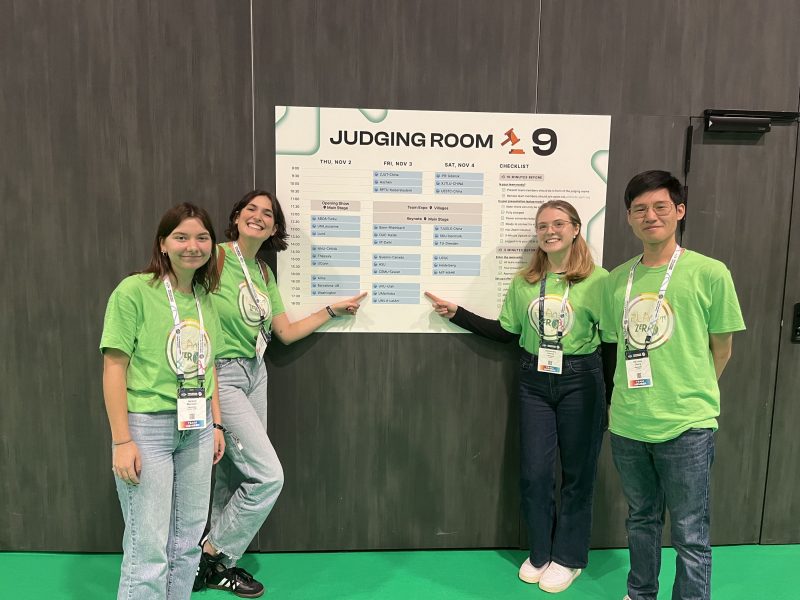
The planet is paying for your iced coffee but it doesn’t have to
Faculty of Science
-
Science students win silver at international biotech competition
Faculty of Graduate Studies, Faculty of Science
-
Science students to compete in Paris – win international biotech grant for zebra mussel control device
Faculty of Science
-

BioExM – Prairie Hub to Power the Bioeconomy with Next-Generation Bio-inspired Technologies
Faculty of Science
Contact us
-
Ned Budisa
Professor, (Tier 1) Canada Research Chair in Synthetic Biology
Department of chemistry
Nediljko.Budisa@umanitoba.ca -
Hans-Joachim Wieden
Professor, Lead for BioSciences Entrepreneurship and Industry Partnerships
Department of microbiology
Hans-Joachim.Wieden@umanitoba.ca

